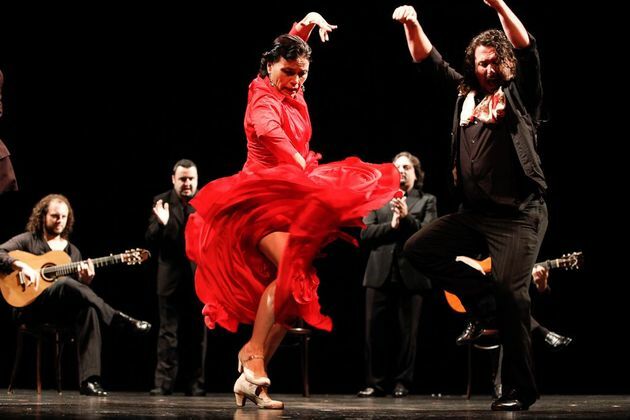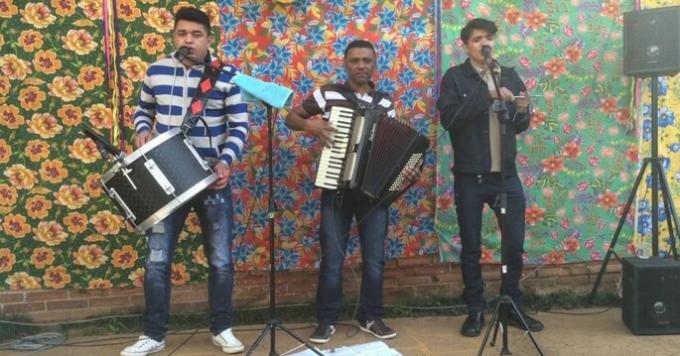Catira, also called Cateretê, is a collective and popular dance of Brazilian folklore.
This expression is typical of the southeast region, however, it was gradually spreading and gaining adherents in other places.
Today we can see this dance in almost all regions of Brazil, especially in the Southeast and Midwest.
Note that this cultural manifestation is mostly found in the interior cities and, therefore, is part of the country culture.

Until today, it is common to observe groups of Catira formed exclusively by men, which are called catireiros.
Origin of Catira
The origin of Catira is multiple, that is, it brings together European, indigenous and African traits. The truth is that since the colonial period we have had this dance as a cultural manifestation.
For some, it is associated with the activities of drovers, which explains its most striking feature, which gathers only men.
Scholars point out that as they transported cattle between places, the dance probably emerged during the group's moments of rest and relaxation.
How to Dance Catira?
This folk dance is marked by the tapping of feet and hands moved by the rhythm of the music, which in turn is produced by the country guitar. For this reason, the viola fashion is the most used rhythm.

In dance, two rows are formed by the members, who move in front of each other. In this way, the tapping of the feet and hands are interspersed with jumps.
It is usually formed by two guitar players and a group of, at most, ten members. But, it should be noted that this can vary depending on where it takes place.
The guitar players can be facing each other, or even facing the other dancers. They are responsible for starting the music, a moment called slashed.
Soon, the dancers make the movement called brush, where there is a quick tapping of the hands and feet, accompanied by six jumps.
Throughout the song, two movements stand out: up saw and down saw. In the first, the dancers rotate one behind the other and from left to right, alternating the tapping of feet and hands.
In the second, and after completing the full turn, they turn and go back (from right to left) with the alternating taps of the feet and hands.
At the cut out, the rows and the dancers change places. Finally, we have the raise, where everyone sings the melody in chorus.
Clothing in Catira
The members of Catira's group have a specific outfit. They wear shirts, pants, hats and boots.
This last prop is perhaps the most important, since they make the beat sound, which joins with the melodies.
In addition, the scarf is very common, with some wearing it around the neck, others around the waist.
Currently, it is already possible to find women who are part of the catireiros group, and even so, the dress is the same.
Catira Video
Catira Songs
Certainly the songs that accompany Catira are related to the culture of the interior and life in the countryside. Check out three of them below:
Homage to Catira (Luiz Fernando and João Pinheiro)
Affirm the foot companion we will enter the function
To sing a cut I changed the tuning
It was to fulfill a request, the call of a brother
There for the bands in Rio Claro, we're going to work
Pros champion of the region
The party will start, open the circle in the hall
Grupo Catira Brasil is a leader in tradition
Good guys on foot don't stand still
It's school in Catira the whole world admires
It comes from six generation
Clap your hands, tap your foot hard on the ground
It's in the Minas Gerais style that I do the greeting
To sing an improvisation I sing perfectly
I sing at any time, I don't play hard guitar
I just like it's a good train
This is the last verse keep the viola and guitar
Here goes our tribute and our handshake
To the friends of Catira, proud of my sertão
For true friends Luiz Fernando and João Pinheiro
Ask for peace and protection.
Catira (Chico Lobo)
To dance the catira
you have to tap your foot
comes a palm later
Just don't dance if you don't want to
Oh, oh, just don't dance if you don't want to
First a tap dance
then a palm
Pro catira come out tasty
It has to be very lively
Oh, oh, it has to be very lively
To dance the catira
There must be good guitar players
us playing the guitar
Can the catireiros come
Oh, there, can the catireiros come
My Catira (Fernando Perillo)
And tap your foot, your foot on the ground
My catira dances like this
If you hear the sound, palms in hand
A viola and a guitar
And stamps his foot, hat in hand
And a feeling that turns into passion
And it comes from there from the heart
sacred place that moves reason
In sunshine, in solitude
My catira cheers the sertão
And tap your foot, the other foot
And clap with the palm of your hand
It comes from the root, it's tradition
So it touches your heart
hey yo yo yo yo yo yo yo you
Curiosity about Catira
Strongly present in popular culture in several states in Brazil, in 2010 the first event took place in the city of Uberaba (MG) National Festival of Catira. There, the second festival took place in 2013.
Folklore Quiz
Do you want to learn about other manifestations of Brazilian folklore? Also read these texts that Toda Matéria prepared for you!
- Frevo: origin, characteristics and types of dance
- Maracatu: characteristics and differences between nation and rural maracatu
- The Folia of Kings in Brazil
- Capoeira: what it is, origin, history, Angola and Regional
- Carimbó: everything about the typical dance of Pará
- Bumba meu boi: origin, legend, dance and parties
- Congada: origin, dance and party
- Quadrilha: origin, dance, music and characteristics
- Samba de Roda: origin, characteristics, dance and music
- History of Forró: origin and characteristics
- Historia do Sertanejo: the music of our sertão



